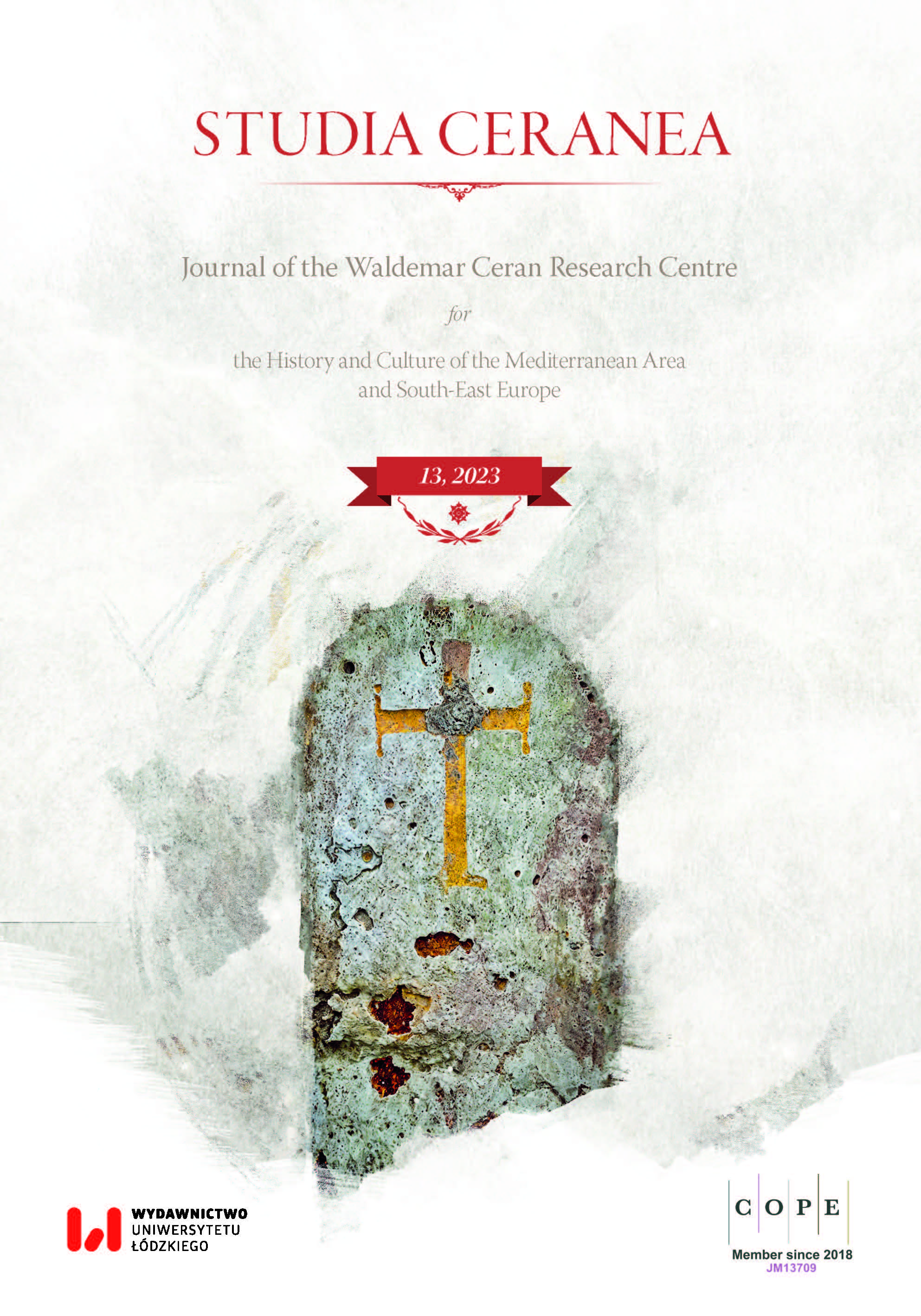Kidney Diseases in the Treatise "Dynameron" of Aelius Promotus (2nd Century AD) A Comparison with Dioscorides and Nikolaos Myrepsos
DOI:
https://doi.org/10.18778/2084-140X.13.31Słowa kluczowe:
Alexandrian medicine, Aelius Promotus, 'Dynameron', Dioscorides, Nikolaos MyrepsosAbstrakt
Dynameron is a medical treatise from the 2nd century AD, written in Greek by an Alexandrian physician named Aelius Promotus. A copy made in Sicily during the 16th century is kept in the Marciana Library of Venice (Codex gr. Ζ. 295). In 130 chapters, Dynameron contains 870 recipes for the treatment of various diseases. Regarding the kidneys, Aelius describes 32 recipes with herbal (59), animal (6) and mineral (1) ingredients, with diuretic, spasmolytic, analgesic, or antiseptic properties, suitable for treating nephrolithiasis, strangury, dysuria and renal inflammations. Several diuretics of Aelius Promotus are similar to those found in De Materia Medica of Dioscorides (1st century AD). On the other hand, all of them are also included in the treatise Dynameron of Nikolaos Myrepsos, written in the 13th century AD. When the recipes are evaluated as a whole, it is evident that Aelius Promotus was a competent practising physician in a city with a glorious tradition in medicine and sciences.
Pobrania
Bibliografia
Aelius Promotus, Iatrika, Fysika kai Antipathētika, ed. M. Wellmann, “Sitzungsberichte der Königlichen Bayerischen Akademie der Wissenschaften zu München. Historische Classe” 2, 1908, p. 772–777.
Google Scholar
Elio Promoto Alessandrino, Manuale della salute, ed. D. Crismani, Alessandria 2002 [= Hellenica, 9].
Google Scholar
Galeni De compositione medicamentorum secundum locos I–VI, [in:] Claudii Galeni Opera Omnia, vol. XII, ed. C. G. Kühn, Lipsiae 1826.
Google Scholar
Galeni in Hippocratem de natura hominis commentarius, [in:] Claudii Galeni Opera Omnia, vol. XV, ed. C. G. Kühn, Leipzig 1828.
Google Scholar
Nikolaos Myrepsos, Dynameron. Critical Edition, vol. I–II, ed. I. Valiakos, Heidelberg 2020.
Google Scholar
Pedanii Dioscoridis Anazarbei De Materia Medica, libri V, vol. I–III, ed. M. Wellmann, Berolini 1906–1914.
Google Scholar
Suidae Lexicon, ed. I. Bekker, Berlin 1854.
Google Scholar
Der Traktat περί τῶν ἰοβόλων θηρίων καὶ δηλητηρίων φαρμάκων des sog. Aelius Promotus, ed. S. Ihm, Wiesbaden 1995 [= Serta Graeca. Beiträge zur Erforschung griechischer Texte, 4].
Google Scholar
André J., Les noms des plantes dans la Rome antique, Paris 1985.
Google Scholar
Bennett J., Trajan Optimus Princeps, Abingdon 1997.
Google Scholar
Casson L., Libraries in the Ancient World, New Haven Connecticut 2001.
Google Scholar
Faridi P., Seradj H., Mohammadi-Samani S., Vossoughi M., Mohagheghzadeh A., Roozbeh J., Randomized and Double-blinded Clinical Trial of the Safety and Calcium Kidney Stone Dissolving Efficacy of Lapis judaicus, “Journal of Ethnopharmacology” 156, 2014, p. 82–87, https://doi.org/10.1016/j.jep.2014.08.003
Google Scholar
DOI: https://doi.org/10.1016/j.jep.2014.08.003
Grimm-Stadelmann I., Untersuchungen zur iatromagie in der Byzantinischen Zeit. Zur Tradierung gräkoägyptischer und spätantiker iatromagischer Motive, Berlin–Boston 2020 [= Byzantinisches Archiv. Series Medica, 1], https://doi.org/10.1515/9783110619041
Google Scholar
DOI: https://doi.org/10.1515/9783110619041
Hematuria, [in:] Merriam-Webster.com Dictionary, https://www.merriam-webster.com/dictionary/hematuria [30 X 2022].
Google Scholar
Horrocks G., Greek. A History of the Language and its Speakers, New York 2010, https://doi.org/10.1002/9781444318913
Google Scholar
DOI: https://doi.org/10.1002/9781444318913
Jackson R., La Niece S., A Set of Roman Medical Instruments from Italy, “Britannia” 17, 1986, p. 119–167, https://doi.org/10.2307/526543
Google Scholar
DOI: https://doi.org/10.2307/526543
Langkavel B., Botanik der spaeteren Griechen vom Dritten bis Dreizehnten Jahrhundert, Berlin 1866, https://doi.org/10.5962/bhl.title.10990
Google Scholar
DOI: https://doi.org/10.5962/bhl.title.10990
MacLeod R., Alexandria in History and Myth, [in:] The Library of Alexandria, Centre of Learning in the Ancient World, ed. R. Mac Leod, New York–London 2000, p. 1–18.
Google Scholar
Makbul S. A.A., Jahan N., Ahmad G., Hajrul yahood (Lapis judaicus): An Important Mineral Drug of Unani System of Medicine for the Management of Urolithiasis, “Journal of Ethnopharmacology” 222, 2018, p. 165–170, https://doi.org/10.1016/j.jep.2018.04.047
Google Scholar
DOI: https://doi.org/10.1016/j.jep.2018.04.047
Milne J. S., Surgical Instruments in Greek and Roman Times, with Illustrations, Oxford 1907.
Google Scholar
Nutton V., Ancient Medicine, London–New York 2013, https://doi.org/10.4324/9780203081297
Google Scholar
DOI: https://doi.org/10.4324/9780203081297
Nutton V., The Chronology of Galen’s Early Career, “Classical Quarterly” 23, 1973, p. 158–171, https://doi.org/10.1017/S0009838800036600
Google Scholar
DOI: https://doi.org/10.1017/S0009838800036600
The Plant List, http://www.plantlist.org [30 X 2022].
Google Scholar
Redwood T., Gray’s Supplement to Pharmacopoeia: Being a Concise but Comprehensive Dispensatory, 2London 1848.
Google Scholar
Schauenberg P., Paris F., Guide des plantes médicinales, Neuchâtel 1977.
Google Scholar
Shoja M. M., Tubbs S. R., Bosmia A. N., Fakhree M. A.A., Jouyban A., Balch M. W., Loukas M., Khodadoust K., Khalili M., Eknoyan G., Herbal Diuretics in Medieval Persian and Arabic Medicine, “Journal of Alternative and Complementary Medicine” 21.6, 2015, p. 309–320, https://doi.org/10.1089/acm.2015.0031
Google Scholar
DOI: https://doi.org/10.1089/acm.2015.0031
Totelin L., Hippocratic Recipes. Oral and Written Transmission of Pharmacological Knowledge in Fifth- and Fourth-Century Greece, Leiden–Boston 2009 [= Studies in Ancient Medicine, 34], https://doi.org/10.1163/ej.9789004171541.i-366
Google Scholar
DOI: https://doi.org/10.1163/ej.9789004171541.i-366
Valiakos E., Marselos M., Skaltsa H., Inorganic Substances and their Uses in Nikolaos Myrepsos’ Dynameron. Recent Applications in Modern Therapy, “Toxicology Reports” 8, 2021, p. 1792–1802, https://doi.org/10.1016/j.toxrep.2021.10.009
Google Scholar
DOI: https://doi.org/10.1016/j.toxrep.2021.10.009
Valiakos E., Marselos M., Grafakou M. E., Skaltsa H., Sakellaridis N., Remedies of Animal Origin and their Indications in Nikolaos Myrepsos’ Dynameron, “Journal of Ethnopharmacology” 276, 2021, p. 114–191, https://doi.org/10.1016/j.jep.2021.114191
Google Scholar
DOI: https://doi.org/10.1016/j.jep.2021.114191
Valiakos E., Marselos M., Sakellaridis N., Constantinidis T., Skaltsa H., Ethnopharmacological Approach to the Herbal Medicines of the “Antidotes” in Nikolaos Myrepsos’ Dynameron, “Journal of Ethnopharmacology” 163, 2015, p. 68–82, https://doi.org/10.1016/j.jep.2015.01.005
Google Scholar
DOI: https://doi.org/10.1016/j.jep.2015.01.005
Valiakos E., Marselos M., Sakellaridis N., Constantinidis T., Skaltsa H., Ethnopharmacological Approach to the Herbal Medicines of the “Elements Alpha to delta” in Nikolaos Myrepsos’ Dynameron. Part II, “Journal of Ethnopharmacology” 205, 2017, p. 246–260, https://doi.org/10.1016/j.jep.2017.04.021
Google Scholar
DOI: https://doi.org/10.1016/j.jep.2017.04.021
Yarnell E., Touwaide A., Accuracy of Dioscorides’, De materia medica (First Century C. E.), Regarding Diuretic Activity of Plants, “Journal of Alternative and Complementary Medicine” 25.1, 2018, p. 1–14, https://doi.org/10.1089/acm.2018.0251
Google Scholar
DOI: https://doi.org/10.1089/acm.2018.0251
Pobrania
Opublikowane
Jak cytować
Numer
Dział
Licencja

Utwór dostępny jest na licencji Creative Commons Uznanie autorstwa – Użycie niekomercyjne – Bez utworów zależnych 4.0 Międzynarodowe.














